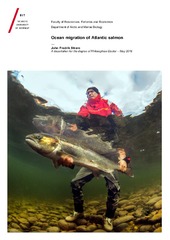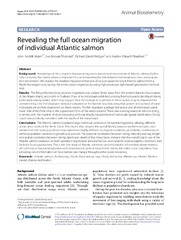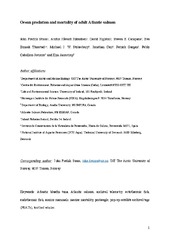| dc.contributor.advisor | Audun Håvard, Rikardsen | |
| dc.contributor.author | Strøm, John Fredrik | |
| dc.date.accessioned | 2018-09-06T09:28:25Z | |
| dc.date.available | 2018-09-06T09:28:25Z | |
| dc.date.issued | 2018-09-14 | |
| dc.description.abstract | Atlantic salmon is experiencing population declines throughout most parts of its distribution range, with changes in the marine environment considered important contributors to the overall decline. Most of the current knowledge about Atlantic salmon’s ocean distribution originates from mark-recapture and genetic studies associated with high-sea fisheries and sampling surveys, and therefore, little is known about individuals’ movements while at sea. For a greater understanding of the ecological conditions encountered in the marine environment, detailed information of the ocean migration and behaviour is needed. The aims of this thesis were to record the ocean migration and behavioural ecology for post-spawned Atlantic salmon from the Alta River, Norway, and the Miramichi River, Canada, and to quantify the marine mortality of post-spawned adults from large parts of the species’ distribution range, using archival telemetry.
Results in this thesis documented that Atlantic salmon from the Alta River displayed an overall fidelity towards Arctic areas, with individual migration routes extending from the eastern Barents Sea to the Jan Mayen Island. These results support recent studies, suggesting that the utilization of these waters has previously been underestimated, particularly for the northernmost populations. In comparison, Atlantic salmon from the Miramichi River displayed an exclusive utilization of the Gulf of St. Lawrence and the Labrador Sea during their ocean migration. Individual migration routes diversified shortly after ocean entry, and after existing the Gulf of St. Lawrence, the overall distribution spanned large parts of the Labrador Sea. The overall variation in ocean migration documented in this thesis indicates that individuals from the same population may experience different ecological conditions during the marine phase, potentially contributing to within-population variation in growth and survival.
During the ocean migration, Atlantic salmon displayed an overall pelagic behaviour. Individuals spent most of their time in the upper 10 m of the water column, diving frequently during daylight hours. For Atlantic salmon from the Alta River, there was a clear seasonal trend in diving intensity, with less diving during the winter, independent of individuals’ spatial distribution. In contrast, for Atlantic salmon from the Miramichi River, the overall trend in diving behaviour depended strongly on which habitat they occupied. As diving behaviour is likely a suitable proxy for foraging in Atlantic salmon and other pelagic fishes, these results indicate that individuals from both populations displayed flexible foraging strategies during their ocean migration, governed by seasonal variation and habitat-specific characteristics.
Furthermore, this thesis documented that a variety of large marine animals, including large fish and toothed whales, preyed on Atlantic salmon during their time at sea. Predation by endothermic fish was most common, occurring primarily in the Gulf of St. Lawrence and in waters spanning from west of the Irish Shelf to the Bay of Biscay. Fewer predation events and mortalities were recorded for Atlantic salmon from northern Europe, which contrasted the higher predation rates and total mortality observed for populations from Canada, Spain, and Ireland.
In conclusion, this thesis revealed several novel aspects of the ocean migration of individual Atlantic salmon and large geographical variation in the ocean mortality. This information is important towards a greater understanding of the ecological process governing Atlantic salmon’s growth and survival in the ocean, which should be further investigated in future research. | en_US |
| dc.description.doctoraltype | ph.d. | en_US |
| dc.description.popularabstract | During the past decades Atlantic salmon have experienced population declines throughout its distribution range, partially due to changes in the marine environment. Despite this, little is detailed information exist of individuals’ movements in the ocean as most knowledge about Atlantic salmon’s ocean distribution originates from mark-recapture and genetic studies associated with high-sea fisheries and sampling surveys. For a greater understanding of the ecological conditions encountered in the marine environment, detailed information of the ocean migration and behaviour is needed. The aims of this thesis were to record the ocean migration of post-spawned Atlantic salmon from the Alta River, Norway, and the Miramichi River, Canada, and to quantify the marine mortality of post-spawned adults from large parts of the species’ distribution range, using electronic tags that record and store data about the behaviour of the individual and the habitat they occupy.
Results in this thesis documented that Atlantic salmon from the Alta River used Arctic areas, with individual migration routes extending from the eastern Barents Sea to the Jan Mayen Island. In comparison, Atlantic salmon from the Miramichi River displayed an exclusive utilization of the Gulf of St. Lawrence and the Labrador Sea during their ocean migration. For both populations, a substantial variation in horizontal migration routes was detected, suggesting that individuals from the same population may experience different ecological conditions during the marine phase, potentially contributing to within-population variation in growth and survival.
During the ocean migration, Atlantic salmon spent most of their time in the upper 10 m of the water column, diving frequently during daylight hours. For Atlantic salmon from the Alta River, there was a clear seasonal trend in diving intensity, with less diving during the winter. In contrast, for Atlantic salmon from the Miramichi River, the overall trend in diving behaviour depended strongly on which habitat they occupied. As diving behaviour is likely a suitable proxy for foraging in Atlantic salmon, these results indicate that individuals from both populations displayed flexible foraging strategies during their ocean migration.
Furthermore, this thesis documented that a variety of large marine animals, including large fish and toothed whales, preyed on Atlantic salmon during their time at sea. Predation by endothermic fish was most common, occurring primarily in the Gulf of St. Lawrence and in waters spanning from west of the Irish Shelf to the Bay of Biscay. Fewer predation events and mortalities were recorded for Atlantic salmon from northern Europe, which contrasted the higher predation rates and total mortality observed for populations from Canada, Spain, and Ireland.
In conclusion, this thesis revealed several novel aspects of the ocean migration of individual Atlantic salmon and large geographical variation in the ocean mortality. This information is important towards a greater understanding of the ecological process influencing Atlantic salmon’s growth and survival in the ocean. | en_US |
| dc.description | Paper II is not available in Munin.<p>
<p>Paper II: Strøm, J.F., Thorstad, E.B., Chafe, G., Sørbye, S.H., Righton, D., Rikardsen, A.H., & Carr, J. (2017). Ocean migration of pop-up satellite archival tagged Atlantic salmon from the Miramichi River in Canada. Available in <a href=https://doi.org/10.1093/icesjms/fsw220>ICES Journal of Marine Science, 74(5), 1356-1370.</a> | en_US |
| dc.identifier.isbn | 978-82-8266-157-7 | |
| dc.identifier.uri | https://hdl.handle.net/10037/13694 | |
| dc.language.iso | eng | en_US |
| dc.publisher | UiT The Arctic University of Norway | en_US |
| dc.publisher | UiT Norges arktiske universitet | en_US |
| dc.rights.accessRights | openAccess | en_US |
| dc.rights.holder | Copyright 2018 The Author(s) | |
| dc.rights.uri | https://creativecommons.org/licenses/by-nc-sa/3.0 | en_US |
| dc.rights | Attribution-NonCommercial-ShareAlike 3.0 Unported (CC BY-NC-SA 3.0) | en_US |
| dc.subject | Ecology | en_US |
| dc.subject | Økologi | en_US |
| dc.subject | Behavioural ecology | en_US |
| dc.subject | Adferdsøkologi | en_US |
| dc.subject | Atlantic salmon | en_US |
| dc.subject | Villaks | en_US |
| dc.subject | Ocean migration | en_US |
| dc.subject | Havvandring | en_US |
| dc.subject | VDP::Landbruks- og Fiskerifag: 900::Fiskerifag: 920 | en_US |
| dc.subject | VDP::Agriculture and fishery disciplines: 900::Fisheries science: 920 | en_US |
| dc.title | Ocean migration of Atlantic salmon | en_US |
| dc.type | Doctoral thesis | en_US |
| dc.type | Doktorgradsavhandling | en_US |


 English
English norsk
norsk


